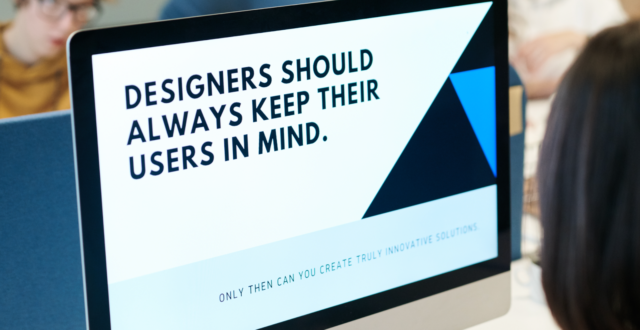It’s (almost) 2024, and if you’re not already designing for accessibility, you’re behind. If you find yourself playing catch-up, don’t worry— you’re not alone. This article aims to equip you with the necessary tools to advocate for accessibility effectively, ensuring that the right stakeholders not only listen but also make a change.
By now, you’re likely well-versed in the ethical and legal importance of accessibility. It’s heartening to see the long way that accessibility has come, from a mere “nice-to-have” feature to becoming a vital component for the web and beyond. No longer relegated to the sidelines as a tick box under “other” or “miscellaneous” groupings, accessibility has rightfully claimed its place at the forefront of the digital discourse.
In fact, many of us here at Hallam are quite passionate advocates ourselves — Harry, our Senior Front End Developer, has written about Accessible Rich Internet Applications (ARIA), designing headers for users with visual impairment, and designing with colour blindness in mind. Meanwhile, our Head of Experience, Francis, offers a comprehensive introduction into web accessibility principles and actionable tips to improve your website today.
But there’s still a lot of work to do.
While we are lucky to have a team that cares, and by principle, will ensure accessibility is built into all of our websites, the unfortunate reality is that when it comes to execution, budgets and constraints will force many of us into continually having to make a strong case for investing in accessibility, and justifying why we should settle for a tradeoff elsewhere.
In order to navigate through this reality, we need to speak the language that senior management will perk up their ears for, and guide them in recognising the tangible benefits of accessible design.
The unexplored market opportunity
First, let’s define the market. Have you ever heard of the “purple pound”? This term, coined by a non-profit organisation Purple, reframes how businesses perceive consumers with disabilities by changing “the conversation from one of disadvantage and inequality to one about potential and value”.
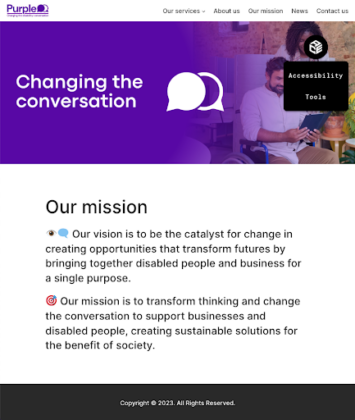 Purple’s mission statement from their website
Purple’s mission statement from their website
Purple tries to undo the isolation of the disabled community and dispel misunderstandings that arise from societal fears of being offensive or politically incorrect. They work with businesses to foster understanding about the win-win situation of working together with disabled people that also benefits society.
This new narrative is one that you can consider adopting into your business case.
This is a huge scale
Presenting statistics together with a compelling storyline can be highly impactful and persuasive.
Rather than overwhelming your big-picture oriented leaders with detailed demographics, let’s focus on the most powerful statistics: There is currently an unexplored market worth £17.1 billion. This value represents the spending power of the 4.5 million disabled online shoppers who click away from an inaccessible website, and is a significant missed opportunity.
The spending power of disabled people and their families is worth £274 billion per year to UK businesses. For global companies, this figure expands to almost £7 trillion. Notice how this second set of statistics includes the keywords “and their families”. Close friends and family to people with disabilities are often influenced by the experiences of people with disabilities, too, creating a powerful revenue stream with untapped potential.
Cost-efficiency is twofold
Cost-efficiency is not always about earning more money—it’s equally about how much you save.
There are very obvious reasons why businesses are now digitising: to improve cost-efficiency, and digitising with accessibility built-in is even more so. If you’re a smaller company that’s just starting out, you’re in for even greater returns. Starting early and embedding accessibility into your business right from the start shields you from costly post-implementation adjustments, which can be 30x more expensive.
It’s always a good idea to start early and consider the long-term benefits. But if accessibility ever becomes deprioritised within your company, just remember that it’ll eventually become a legal mandate in more and more countries, so it’s only a matter of time before you’re forced to do it anyway. Why not start now and save yourself from the inevitable costs of leaving it for later?
Naturally sticky behaviour
Unfortunately, people with disabilities often encounter websites and businesses that have overlooked their needs. This has become standard rather than the exception. Even more disheartening is that this revelation hardly comes as a surprise to anyone.
However, this also means that if your business is disabled friendly, you can be assured that you’ll gain the fierce loyalty of these users — or in other words, “sticky customers”. If you consider the dreary process of shopping around in dismay, only to finally find a business that has genuinely considered your needs, it makes sense that one would want to stick around and continue with a brand that they’re now comfortable and happy with.
Ultimately, businesses want less churn, and more customer longevity.
Research also reveals other interesting purchasing behaviours of this customer group, such as higher spending per transaction, and more shopping instances when compared to the average consumer.
I don’t know about you, but this sounds like the ideal target customer.
Make it about people
If you’ve gotten this far in the article, it’s probably safe to assume that you care (at least a little) about people…(you do, right?)! This is something you have in common with your stakeholders, and can leverage.
If your company is serving any type of customer in any industry, chances are, customer experience (CX) is something stakeholders will care about, because excellent CX is “crucial in an age when how a business delivers for its customers is just as important as—if not more important than—the products and services it provides”.
Oh, and did I mention that better CX can result in 3x shareholder returns?
Consider engaging your stakeholders in an empathy exercise. Taking a page straight from the book of design thinking, this method helps teams better understand users by putting themselves in their shoes, fostering a realistic perspective of challenges and inspiring proactive solutions. By painting a picture of another’s struggles, one may more easily feel the need to do something about it.
Illustrate the following scenarios for your group:
Situation A: You’ve dropped your mouse (which you use on a desktop computer without a trackpad) and now it no longer works. The only option you have to navigate the web now is using your keyboard, but you encounter a screen that looks like this: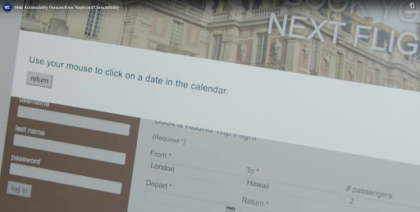
A website with a popup that cues the user to use a mouse in order to complete a task, without a keyboard friendly option. Those with physical disabilities or chronic conditions may be unable to use a mouse or see a pointer on the screen, thus all website functionalities need to be compatible with keyboard controls (Source)
Situation B: You’re in the library and forgot your headphones. You’re trying to watch a video where you need to gather knowledge for work, but it doesn’t have captions, so you have no idea what’s going on. Now, you can’t complete the work you’ve come here to do.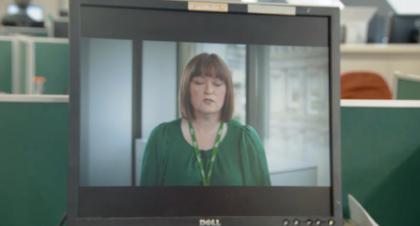
A video without captions would make you wonder: What are they saying? What’s happening? Frustrating, isn’t it? For people who are hard of hearing, deaf, or have other learning disabilities, captions are essential to their understanding (Source)
Situation C: It’s a sunny day and you’re outside exploring a new town. You need to look up directions using a navigation app, but you can hardly see anything on the screen because the bright sunshine is affecting your vision, and the muted colour palette of the app plus thin font style does not help.
Looking at a phone screen outdoors requires much more contrast in the design to see properly. Meanwhile, people who are affected by colour blindness, or deteriorating contrast sensitivity (which becomes more common as you age) are dependent on sufficient contrast to decipher any information on the screen (Source)
Situation D: You are someone who loves to multitask! So when doing lower-cognitive activities like washing the dishes, you’d love to be able to listen to the news or read a book.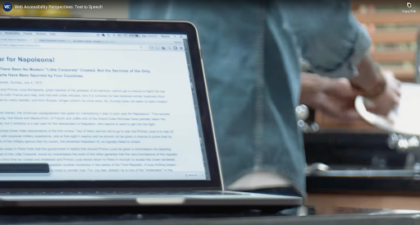
A properly coded website can allow screen readers and other text-to-speech software to provide read-aloud functions for users. People with dyslexia and other cognitive disabilities are dependent on features like this as they need to hear and see the text to better understand it (Source).
What these above situations illustrate are examples of what we call “situational accessibility,” whereby everybody can feel the impacts of inaccessible design in a variety of situations, even if one does not have a permanent disability. Therefore, the flip side of this is that everyone can benefit from having accessible design.
W3C accurately sums up accessibility as “essential for some, useful for all”. Or as Microsoft puts it, “solve for one, extend to many”. Here is a visual cheatsheet—one of my favourites—to understand how an accessibility solution can scale to a much broader audience: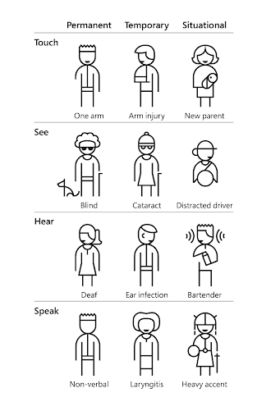 Microsoft’s Inclusive Design Persona Spectrum (Source)
Microsoft’s Inclusive Design Persona Spectrum (Source)
So in providing a more accessible website, you not only better serve those with disabilities, but you’ll also create a much smoother experience for all people, including your customers.
… it also leads to innovation
A research study of Fortune 100 companies indicates that disability inclusion, as part of an overall diversity strategy, is common practice among high performing businesses.
Take Apple and Google, two of the world’s biggest names, as exemplars:
Ever since Apple designed its first iPhone with touchscreen, they knew that this would have implications for their visually impaired customers, so they sought solutions to meet the needs of these users, eventually developing the voice technology that not only resulted in the first fully accessible touchscreen interface, but has now become a very useful feature for many electronic devices for users of different situations and abilities.
I really like how Eve Andersson, Google’s Senior Director at Products for All, puts it:
“The accessibility problems of today are the
mainstream breakthroughs of tomorrow.”
This is the philosophy that has led to Google’s development of many essential innovations that have removed many barriers for disabilities, such as auto-complete for text and auto-captioning using machine learning, plus many other efforts to improve experiences for all.
Carrots, now the sticks
If we are talking about business, we can’t neglect a conversation about risks. It’s no mystery that governments and regulators are now (rightfully so) taking a stricter stance on enforcing laws and policies that will strengthen the rights of people with disabilities to participate and utilise digital platforms fairly and equally.
For companies operating in Europe, the European Accessibility Act will be legally enforced by 28 June 2025. This is your deadline—but one would be smart to act as early as you can.
It’s important for businesses — particularly those who have a global presence — to adhere to these guidelines, policies, and laws, in order to mitigate risks and protect their reputation, which in turn helps keep your business afloat.
Summary
We’ve unpacked a lot about the business case for accessibility in this article, so to sum it up:
- Tap into the “purple pound” market opportunity that continues to expand
- People with disabilities (and their close friends and family) have a tendency to be more loyal, with higher spending and more frequent transactions
- Early accessibility integration is cost-effective and helps avoid the exponential costs of implementing after something has been built
- Designing for disabilities benefits all and drives innovation
- Accessibility compliance is only going to become stricter over time, so mitigate risks and protect your business’ reputation by starting now
At the end of the day, accessibility really is about people. Access is a basic human right, and we should all be able to enjoy digital experiences, products, and services equally.
If nothing gets past your stakeholders, consider an emotional appeal to be your last resort. You’d be surprised how much impact a well-intended, genuine conversation can have with somebody.
Let’s do our part and make things better for the people that need it more than most. If you’d like advice for building an accessible website, don’t hesitate to get in touch with our design team.



